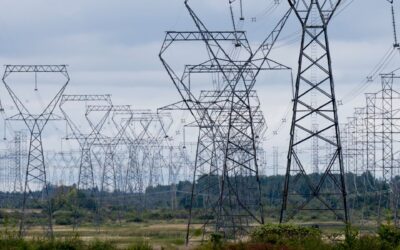It’s a mark of how much momentum the global and national response to climate change now has that—despite numerous domestic and geopolitical headwinds—the past twelve months have resulted in significant progress.
In March 2022, Canada’s first Emissions Reduction Plan set the agenda for future policy development. The Canadian Climate Institute’s detailed assessment of this plan concluded that—if swiftly implemented— it has the potential to deliver on the country’s emissions reduction obligations. Significantly, just five policies are needed to get us most of the way to Canada’s 2030 emissions targets. Of those five, three could be finalized in 2023: the cap on emissions from the oil and gas sector, the Clean Electricity Regulation, and improvements to carbon pricing. Let’s take each in turn.
Firstly, the oil and gas cap is crucial, since our research confirms that the oil and gas sector will overshoot its 2030 goal without regulation. Between 2005 and 2019, emissions from oil and gas rose by almost 20 per cent. The cap will need to be stringent and implemented well, along with tighter methane controls, in order to make the kind of deep and rapid emission reductions required to bring this sector in line with Canada’s 2030 target.
Secondly, the federal government has committed that Canada’s electricity generation will be net zero by 2035. This target is ambitious but achievable, recognizing that Canada’s clean electricity production must increase significantly to meet our emissions reduction commitments in 2030 and 2050 and that the creation of a Net Zero electricity grid is a precondition for decarbonizing other sectors. If done right, this new framework for clean electricity has the potential to underpin significant new economic opportunities and actually make the overall cost of energy more affordable for Canadians.
Finally, this past year saw strong traction for policy ideas to provide greater certainty around the future carbon price, without which investors will be reluctant to make large multi-year commitments. An innovative approach, carbon contracts for differences, could be fully realized in 2023. If correctly implemented, these contracts could open the investment floodgates by enmeshing carbon pricing more closely into the financial system and unleashing the creativity of the markets in driving Canada toward net zero.
These necessary new Canadian policies need to be seen against a backdrop of significant global progress. The European Union continues to accelerate its Green Deal, a new growth strategy to transition the EU economy to a sustainable economic model, on the way becoming the first climate neutral continent by 2050. Our biggest trading partner, the U.S., has just enacted by far the most extensive investment in climate solutions in its history in the form of the Inflation Reduction Act. After years of seeing U.S. inaction on climate used as a reason for Canada not to move too quickly, we’re suddenly under pressure to go faster.
There’s also pressure to move more quickly in terms of adaptation. Every part of Canada is now feeling the effects of climate change, and every year, multiple climate-fuelled disasters claim the lives of Canadians and drain billions from our economy. Last month, the federal government released its first National Adaptation Strategy (NAS), a first step along the path toward a safer and more resilient Canada. The principles of the NAS now need to be translated into rapid action.
All of this will require investment. The federal government’s new Canada Growth Fund will seek to use public support to mobilize private capital. And new work with the Sustainable Finance Action Council will make it easier and faster to determine whether potential investments align with Canada’s climate goals and a stable climate internationally, thus helping to attract more green capital to Canada.
As the federal government moves forward with these big policy pieces, the important role of provinces and territories increasingly comes into focus. There are many levers that provinces can pull to reduce emissions, including carbon pricing, building codes, transit, housing policy, and more. Above all, provincial regulatory commitment and interprovincial collaboration will be essential to achieve Canada’s clean electricity objective. In short, we need to see more leadership on the provincial and territorial level: fast.
Indigenous governments continued to show leadership in the energy transition in 2022, with communities leading the switch to non-emitting electricity. With the right support, Indigenous-led clean energy projects could see exponential growth in 2023 and beyond.
While this past year saw some milestone moments for climate policy, next year will be even more important and tangible as Canada steps up implementation while getting the details of specific policies right. The Canadian Climate Institute will continue to lead the discussion by anticipating upcoming policy needs and reacting with timely analysis. The next twelve months will be packed: with new data insights from our recently launched 440 Megatonnes project, as well as a major building heating study, engagement with the implementation of the NAS, and a renewed focus on oil and gas, as well as clean growth. Our goal remains the same: creating durable, effective climate policy to ensure Canada’s continued prosperity and the safety and resilience of our communities.








